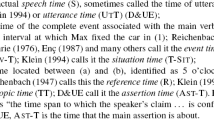Abstract
In this paper, I argue that the temporal connective prima (‘before’) is a comparative adverb. The argument is based on a number of grammatical facts from Italian, showing that there is an asymmetry between prima and dopo (‘after’). On the ground of their divergent behaviour, I suggest that dopo has a different grammatical status from prima. I propose a semantic treatment for prima that is based on an independently motivated analysis of comparatives which can be traced back to Seuren (in: Kiefer and Ruwet (eds.) Generative grammar in Europe, 1973). Dopo is analyzed instead as an atomic two-place predicate which contributes a binary relation over events to the sentence meaning. The different semantic treatments of the two connectives provide an explanation for the grammatical asymmetries considered at the outset; interestingly, they also shed some light on other asymmetries between prima and dopo, which are known to hold for the English temporal connectives before and after as well: these asymmetries are related to the veridicality properties, the distribution of NPIs, and the logical properties of these connectives first described in Anscombe (Philos Rev 73:3–24, 1964).
Similar content being viewed by others
References
Anscombe G.E.M. (1964). Before and after. The Philosophical Review 73(1): 3–24
Beaver, D., and C. Condoravdi. 2003. A uniform analysis of before and after. In Proceedings from SALT 13, 37–54. Ithaca, NY: CLC Publications.
Blaszczak, J. 2001. Investigation into the interaction between the indefinites and negation. Studia Grammatica. Berlin: Akademie Verlag.
Bonomi, A. 2005. The gradable predicate ‘actuale’. Ms, University of Milan.
Bresnan J. (1973). Syntax of the comparative clause construction in English. Linguistic Inquiry 4: 275–343
Corblin F., Tovena L.M. (2003). L’expression de la négation dans les langues romanes. In Les langues romanes: problémes de la phrase simple, ed. D. Godard, 281–343. Paris: CNRS Editions.
Cresswell, M.J. 1976. The semantics of degree. In Montague grammar, ed B.H. Partee, 261–292. New York: Academic Press.
Donati C. (2000). La sintassi della comparazione. Unipress, Padova
Espinal M.T. (2000). Expletive negation, negative concord and feature checking. Catalan Working Papers in Linguistics 8: 47–69
Heim, I. 1999. Notes on superlatives. Ms, MIT.
Heim I. and Kratzer A. (1998). Semantics in generative grammar. Blackwell, Malden & Oxford
Heinämäki, O. 1974. Semantics of English temporal connectives. PhD dissertation, University of Helsinki (reproduced by Indiana University Linguistics Club, 1978).
Herburger E. (2001). The negative concord puzzle revisited. Natural Language Semantics 9: 289–333
Higginbotham J. (1988). Is semantics necessary?. Proceedings of the Aristotelian Society 87: 219–241
Ladusaw, W.A. 1979. Polarity sensitivity as inherent scope relations. PhD dissertation, University of Texas at Austin.
Laka Mugarza, I. 1990. Negation in syntax: On the nature of functional categories and projections. PhD dissertation, MIT.
Landman F. (1991). Structures for semantics. Kluwer, Dordrecht
Longobardi, G. 1986. In defense of the “Correspondence Hypothesis”: Island effects and parasitic gap construction in logical form. Ms, Scuola Normale Superiore, Pisa.
Ogihara, T. 1995. Non-factual before and adverbs of quantification. In Proceedings from SALT 5, 273–291. Ithaca, NY: DMLL Publications, Cornell University.
Parsons, T. 1985. Underlying events in the logical analysis of English. In Actions and events: Perspectives on the philosophy of Donald Davidson, ed. E. LePore and B. McLaughlin, 235–267. Oxford: Basil Blackwell.
Parsons T. (1990). Events in the semantics of English: A study in subatomic semantics. MIT Press, Cambridge, MA
Seuren, P.A.M. 1973. The comparative. In Generative grammar in Europe, ed. F. Kiefer and N. Ruwet, 528–564. Dordrecht: Reidel.
Valencia, V.S., T. van der Wouden, and F. Zwarts. 1994. Polarity, veridicality, and temporal connectives. In Proceedings of the Ninth Amsterdam Colloquium, ed. P. Dekker and M. Stokhof, 587–606. University of Amsterdam.
Stechow A. (1984). Comparing semantic theories of comparison. Journal of Semantics 3: 1–77
von Stechow, A. 2006. Times as degrees: früh(er) ‘early(er)’ / spät(er) ‘late(r)’, and phase adverbs. Ms, Universität Tübingen. Paper available at http://vivaldi.sfs.nphil.uni-tuebingen.de/~arnim10/.
Zanuttini, R. 1989. The structure of negative clauses in Romance. Ms, University of Pennsylvania.
Zeijlstra H. (2004). Sentential negation and negative concord. Utrecht, LOT
Zwarts, F. 1998. Three types of polarity. In Plurality and quantification, ed. F. Hamm and E. Hinrichs, 177–238. Dordrecht: Kluwer.
Author information
Authors and Affiliations
Corresponding author
Additional information
I am indebted to Andrea Bonomi, Paolo Casalegno, Gennaro Chierchia, and Alessandro Zucchi for discussion of many aspects of the analysis laid out here. I wish to thank two anonymous reviewers for NALS for comments and suggestions as to how to improve this paper.
Rights and permissions
About this article
Cite this article
Del Prete, F. A non-uniform semantic analysis of the Italian temporal connectives prima and dopo . Nat Lang Semantics 16, 157–203 (2008). https://doi.org/10.1007/s11050-008-9030-6
Published:
Issue Date:
DOI: https://doi.org/10.1007/s11050-008-9030-6




